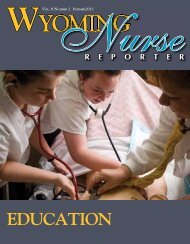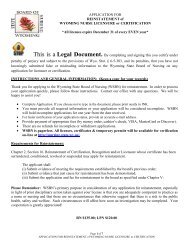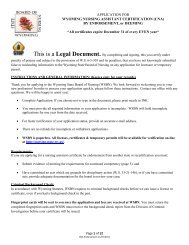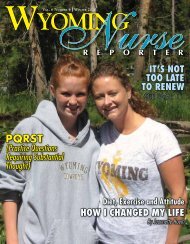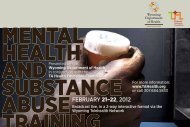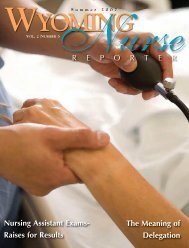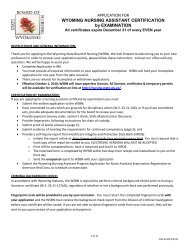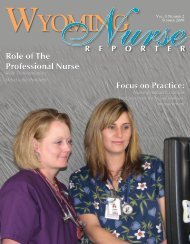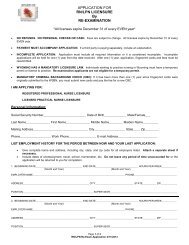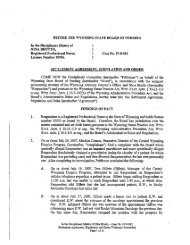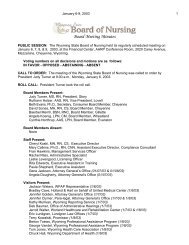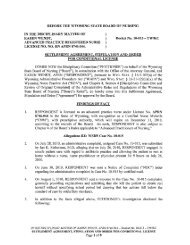Nurse Reporter Fall 2008 - Wyoming State Board of Nursing
Nurse Reporter Fall 2008 - Wyoming State Board of Nursing
Nurse Reporter Fall 2008 - Wyoming State Board of Nursing
You also want an ePaper? Increase the reach of your titles
YUMPU automatically turns print PDFs into web optimized ePapers that Google loves.
e fairly unflinching, but in fact, the NPAleaves significant room for interpretationon a case-by-case basis.First and foremost, each case must beconsidered individually to see if the licenseholder is “unfit or incompetent … topractice nursing with reasonable skill andsafety to patients.” Unfortunately, there isno national consensus on what constitutespr<strong>of</strong>ession-wide competencies and skillsfor nurses, which makes legal interpretation<strong>of</strong> this statement problematic (Helms,Jorgensen, and Anderson, 2006). Thedecision <strong>of</strong> whether a nurse is unfit or incompetentmust be a joint endeavor <strong>of</strong> theregulatory agency, in this case the <strong>Wyoming</strong><strong>State</strong> <strong>Board</strong> <strong>of</strong> <strong>Nursing</strong> (WSBN), theemployer, the nurse in question, and thenurse’s health care provider.In the event <strong>of</strong> substance abuse issues,other parts <strong>of</strong> the NPA become relevant;in many instances, law enforcementagencies are also involved in gatheringevidence and reviewing the case. Currently,45 nurses are enrolled in the <strong>Wyoming</strong>Pr<strong>of</strong>essional Assistance Program (WPAP)for treatment <strong>of</strong> substance abuse/chemicaldependency. At least that many nursesare represented in active open cases underinvestigation by the WSBN. Chemicaldependence is recognized as a disabilityunder the Americans with DisabilitiesAct (ADA); however, the ADA onlyprotects employees from discriminationif they are successfully rehabilitated andno longer abuse the substance in question(Snyder, <strong>2008</strong>). Illegal conduct, such asuse <strong>of</strong> illegal drugs or illegal use <strong>of</strong> legaldrugs, is not conduct for which the ADArequires reasonable accommodation orpermits a disability discrimination lawsuit.This is an important point when discussioncenters around enfolding nurses withdisabilities back into the workforce; nurseswith chemical dependency must no longerbe engaged in illegal activities and must beenrolled in the WPAP (or other rehabilitationprogram) in order to have the opportunityto retain licensure and be permittedto continue practice.However, there are many disabilityissues other than chemical dependencywhen considering how disabled or health-Continued from previous pagecompromised nurses may remain in theworkforce. In just my own personal experienceas a practicing nurse and nurse educator,I have worked with nurses or taughtnursing students affected by multiplehealth issues, whether or not they fullyqualified or identified themselves as beingdisabled: cerebral palsy, congenital limbreduction, hearing impairment, speechimpediment, musculoskeletal problemscausing chronic pain and compromisinggait or movement, Type I and II diabetes,and various mental health disorders such asattention deficit disorder (ADHD), depressionand bipolar disorder. Some <strong>of</strong> thesenurses and nursing students needed specialaccommodations (special stethoscopes forIn this issue <strong>of</strong> the <strong>Wyoming</strong> <strong>Nurse</strong><strong>Reporter</strong>, read the stories <strong>of</strong> nurses herein <strong>Wyoming</strong> who are struggling with thesevery questions. Ask yourself how youfeel about working with nurses who havehealth problems and/or disabilities. Considerhow each <strong>of</strong> us can provide “accommodations”for one another … sometimesas simple as <strong>of</strong>fering compassion and anopen mind.hearing impairment or a particular type<strong>of</strong> chair to support the back/spine). Mostdid not need anything other than understandingand compassionate peers andco-workers.Under specific circumstances, anemployer could attempt to raise questionsregarding a nurse’s fitness or competencyfor any <strong>of</strong> these health problems. Forexample, what if a diabetic nurse experiencedan unrecognized hypoglycemicepisode and made an error in caring for apatient? What if the nurse with a chronicback problem experienced a spasm whenmoving a patient and harmed the patientor exacerbated the injury and neededworkmen’s compensation? An employer, oreven co-workers, concerned with liabilitymay fret over any number <strong>of</strong> potential situationsand fear employing or working withnurses with health problems or disabilities,even if these employees are not asking forspecial accommodations. While employmentlaws and the ADA are designed toprotect the employee’s rights, one cannotlegislate attitudes and beliefs. The grayareas in law, regulation and even our ownpersonal beliefs leave a great deal <strong>of</strong> spacefor what course <strong>of</strong> action may be taken.In this issue <strong>of</strong> the <strong>Wyoming</strong> <strong>Nurse</strong><strong>Reporter</strong>, read the stories <strong>of</strong> nurses herein <strong>Wyoming</strong> who are struggling withthese very questions. Ask yourself howyou feel about working with nurses whohave health problems and/or disabilities.Consider how each <strong>of</strong> us can provide“accommodations” for one another …sometimes as simple as <strong>of</strong>fering compassionand an open mind.The WSBN is actively engaged inworkforce issues here in <strong>Wyoming</strong>. Aspart <strong>of</strong> our mission <strong>of</strong> public protection,the board is charged with regulation andlicensure <strong>of</strong> nursing pr<strong>of</strong>essionals in thestate to ensure a robust nursing workforcefor all <strong>of</strong> the people <strong>of</strong> <strong>Wyoming</strong>.We challenge all <strong>Wyoming</strong> employersand nursing pr<strong>of</strong>essionals to criticallyexamine the issue <strong>of</strong> including nurseswith health challenges and disabilities asvalued members <strong>of</strong> the healthcare team.We welcome your comments on this issue.ReferencesGallagher, T. (<strong>2008</strong>). <strong>Nurse</strong>s in demand:<strong>State</strong>ment <strong>of</strong> the problem. Casper,WY: <strong>Wyoming</strong> Department <strong>of</strong> Employment,Research and Planning o. DocumentNumber)Helms, L., Jorgensen, J., and Anderson,M. A. (2006). Disability law and nursingeducation: An update. Journal <strong>of</strong> Pr<strong>of</strong>essional<strong>Nursing</strong>, 22(3), 190-196.Snyder, E. K. (<strong>2008</strong>). Chemical dependency:Hospital not required to accommodaterestrictions re narcotics, no disabilitydiscrimination. Legal Eagle Eye for theNewsletter for the <strong>Nursing</strong> Pr<strong>of</strong>ession,16(1), 4.Administrative rules and regulations,(2003).4 W y o m i n g N u r s e R e p o r t e r



